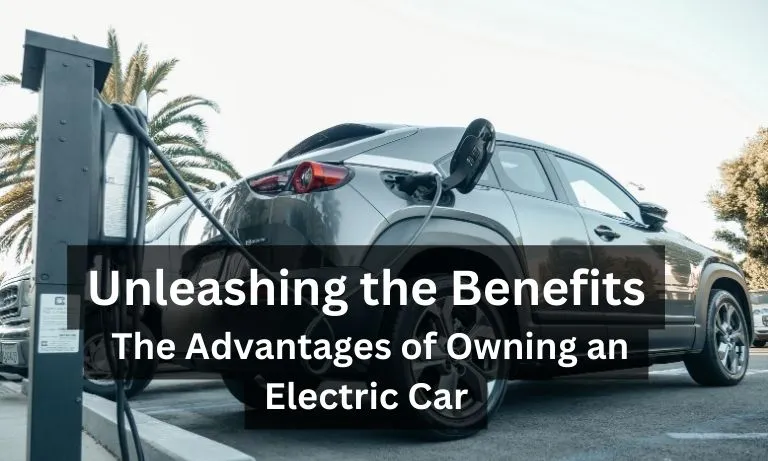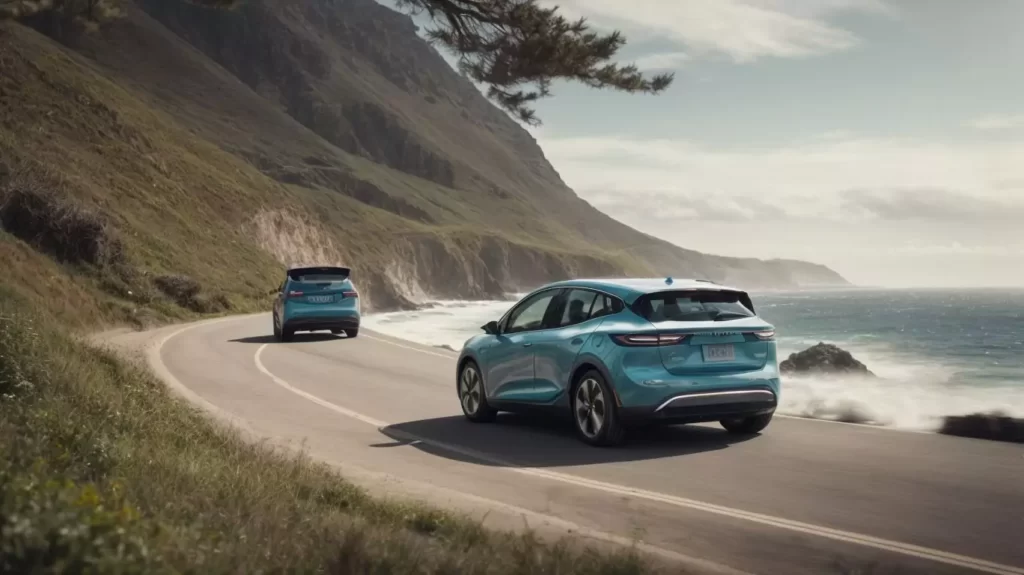Unleashing the Benefits: The Advantages of Owning an Electric Car

Looking to save money on gas and reduce your carbon footprint? If so, then owning an electric car might be the perfect solution for you.
In today’s world of rising gas prices and environmental concerns, electric cars offer a convenient and eco-friendly alternative. But what exactly are the advantages of owning an electric car? Let’s explore and find out.
What Is an Electric Car?
An electric car is a vehicle that utilizes one or more electric motors and rechargeable batteries as its main source of energy. Unlike traditional cars that rely on gasoline or diesel, electric cars run on electricity, making them more environmentally friendly by emitting no tailpipe pollutants and reducing greenhouse gas emissions.
In addition to being eco-friendly, electric cars also have several advantages over conventional vehicles. They are more energy-efficient, converting a higher percentage of the battery’s energy to power the wheels, and have lower operating costs due to the generally cheaper cost of electricity compared to gasoline. Electric cars also provide a smoother and quieter driving experience, with instant torque and reduced engine noise.
While they may have a higher initial cost, government incentives and savings on fuel and maintenance can help offset this expense over time. Overall, electric cars offer a promising alternative to traditional combustion engine vehicles, providing a cleaner and more sustainable form of transportation.
How Do Electric Cars Work?
Electric cars operate by utilizing stored electricity in a battery to power an electric motor, which then propels the vehicle forward by turning the wheels. Here is a step-by-step explanation of how electric cars work:
- Battery pack: Electric cars are powered by a large battery pack, typically made up of lithium-ion cells, which store electricity.
- Charging: The battery pack can be charged by plugging the car into a charging station or a regular electrical outlet.
- Power electronics: The electricity from the battery pack is sent to the power electronics, which convert it from direct current (DC) to alternating current (AC).
- Electric motor: The AC power is then sent to the electric motor, which converts the electrical energy into mechanical energy.
- Transmission: In most electric cars, the electric motor is connected to a transmission, which helps regulate the power and torque sent to the wheels.
- Wheels: Finally, the power from the electric motor is transferred to the wheels, allowing the car to move.
By understanding how electric cars work, consumers can make informed decisions about whether an electric car is the right choice for them and feel confident in their understanding of this innovative technology.
What Are the Advantages of Owning an Electric Car?
Electric cars have been gaining popularity in recent years, and for good reason. They offer numerous advantages over traditional gasoline-powered vehicles. In this section, we will discuss the various benefits of owning an electric car and how they can positively impact both the environment and your wallet. From being environmentally friendly to providing better performance, we will explore the many advantages that come with owning an electric car. So buckle up and get ready to learn about the benefits that make electric cars a smart choice for both you and the planet.

1. Environmentally Friendly
Electric cars are a sustainable and eco-friendly option for those looking to switch from traditional gasoline-powered vehicles. To make a successful transition, here are some steps to follow:
- Research and compare models: Thoroughly research and compare electric car models that align with your needs and preferences.
- Consider your driving habits: Evaluate your daily commute and determine if an electric car’s driving range is suitable for your needs.
- Plan for charging: Make sure to install a home charging station or find public charging stations near your home or workplace.
- Consult with a professional: Seek advice from an electric car expert or visit a dealership for more information and guidance.
By following these steps, you can smoothly transition to an electric car and reap its environmentally friendly benefits. Remember to consider important factors such as driving range, charging infrastructure, and cost when making your decision. Embracing electric cars is a step towards a cleaner and greener future for our planet.
2. Lower Operating Costs
Lower operating costs are one of the main benefits of owning an electric car. Here are some steps to take into consideration in order to minimize your expenses:
- Electricity costs: Research the electricity rates in your area and identify any time-of-use plans that offer lower rates during off-peak hours.
- Reduce maintenance costs: Electric cars have fewer moving parts compared to internal combustion engines, resulting in reduced maintenance needs. Regular maintenance such as oil changes and transmission repairs are not required.
- Government incentives: Check if there are any government incentives or tax credits available for electric car owners. These can help offset the upfront cost of purchasing an electric vehicle.
- Charging options: Explore different charging options to ensure you have access to affordable or free charging stations. Consider installing a home charging station to take advantage of cheaper electricity rates.
- Insurance savings: Some insurance companies offer lower premiums for electric cars due to their lower risk profile and fewer mechanical issues.
By following these steps, you can significantly reduce your operating costs and make owning an electric car more affordable.
3. Tax Incentives and Rebates
Tax incentives and rebates can make owning an electric car more affordable and attractive. Here are the steps to take advantage of these financial benefits:
- Research: Find out about federal, state, and local tax incentives and rebates available for electric car owners.
- Check eligibility: Determine if you meet the criteria for these incentives, such as income limits or specific vehicle requirements.
- Apply for incentives: Fill out the necessary paperwork and submit your application for tax credits or rebates.
- Keep documentation: Maintain records of your purchase, including the vehicle’s purchase price, to support your claim for incentives.
- File taxes: Claim the tax credits on your annual tax return, reducing your overall tax liability.
- Monitor updates: Stay informed about any changes or updates to the incentives and rebates offered to electric car owners.
By following these steps, you can maximize the financial benefits of owning an electric car and contribute to a greener future.
4. Better Performance
Electric cars offer several advantages in terms of performance compared to traditional gasoline-powered vehicles. Here are four steps to understand and appreciate their better performance:
- Acceleration: Electric cars provide instant torque and smooth acceleration. The electric motor delivers power quickly, allowing for faster acceleration compared to internal combustion engines.
- Handling: Electric cars have a lower center of gravity due to the placement of heavy batteries, resulting in improved stability and handling. This translates to better maneuverability and control on the road.
- Silent operation: Electric cars produce little to no noise while driving. The absence of engine noise creates a more peaceful and enjoyable driving experience, making it easier to appreciate the surroundings.
- Regenerative braking: Electric cars utilize regenerative braking, which converts kinetic energy into electricity, thereby recharging the battery. This feature not only improves efficiency but also enhances control and responsiveness while braking.
True story: A friend of mine recently switched to an electric car and was amazed by its performance. The instant acceleration and smooth handling made the driving experience incredibly enjoyable. The car’s silence was also a pleasant surprise, allowing my friend to fully immerse themselves in the peacefulness of the journey. Overall, the better performance of the electric car has made commuting a more exciting and efficient experience for them.
5. Less Maintenance
- Regular Maintenance: Electric cars require less maintenance compared to traditional gasoline vehicles. With no engine oil and fewer moving parts, the maintenance tasks are simplified.
- Brake System: Electric cars utilize regenerative braking, which reduces wear and tear on brake pads and increases their lifespan. This means less frequent replacement.
- Fluids and Filters: Electric cars do not have as many fluids and filters as internal combustion engine vehicles. This reduces the need for regular fluid changes and filter replacements.
- Exhaust System: Since electric cars do not produce emissions, there is no need for an exhaust system. This eliminates the need for maintenance and repairs associated with exhaust systems.
- Engine Tune-ups: Electric cars do not have traditional engines that require tune-ups. This saves time and money on engine maintenance.
What Are the Different Types of Electric Cars?
Electric cars have gained popularity in recent years due to their eco-friendliness and cost-saving benefits. However, not all electric cars are created equal.
In this section, we will explore the different types of electric cars available on the market. From battery electric vehicles (BEVs) to plug-in hybrid electric vehicles (PHEVs) and hybrid electric vehicles (HEVs), we’ll discuss the unique features and advantages of each type. By the end, you’ll have a better understanding of the options available to you when considering an electric car.
1. Battery Electric Vehicles
Battery Electric Vehicles (BEVs) are a type of electric car that runs solely on electricity stored in their rechargeable batteries. If you are considering switching to an electric car, here are some steps to help you make an informed decision:
- Research and Compare Models: Take the time to research different BEV models available in the market. Compare their features, battery range, charging time, and prices.
- Consider Your Driving Habits: Evaluate your daily driving needs and determine if a BEV’s range aligns with your typical driving distance. BEVs are ideal for short to medium commutes or regular city driving.
- Plan for Charging: Assess the availability of charging infrastructure in your area. Make sure you have access to charging stations at home, work, or public locations to support your BEV’s charging requirements.
- Consult with a Professional: Before finalizing your decision, consult with an electric car expert or your local dealer. They can provide you with specific information about BEVs and address any concerns or questions you may have.
By following these steps, you can make an informed choice and successfully transition to owning a Battery Electric Vehicle.
2. Plug-in Hybrid Electric Vehicles
Plug-in Hybrid Electric Vehicles (PHEVs) are a type of electric car that combines an internal combustion engine with an electric motor and a rechargeable battery. These vehicles offer the convenience of being able to run on electric power for shorter trips or use the combustion engine for longer journeys. PHEVs can be charged by plugging them into an electrical outlet or through regenerative braking, which converts kinetic energy into electrical energy to recharge the battery.
The benefits of owning a PHEV include reduced emissions, improved fuel efficiency, and the ability to drive on electric power, resulting in lower operating costs. Additionally, PHEVs often qualify for tax incentives and rebates, making them more affordable.
However, there are some factors to consider. PHEVs typically have a shorter electric-only range compared to Battery Electric Vehicles (BEVs). They also require longer recharge times compared to filling up on gasoline. Additionally, the upfront cost of PHEVs can be higher than traditional internal combustion engine vehicles. Lastly, the availability of charging stations for PHEVs may be limited in certain areas.
To transition to a PHEV, it is important to research and compare models, taking into account factors such as electric range, fuel economy, and available incentives. Evaluate your driving habits to determine if a PHEV would meet your needs. Plan for charging by identifying charging stations in your area or considering installing a home charging station. Finally, consult with a professional to address any questions and concerns specific to PHEVs.
In a historical context, the first production PHEV was the Toyota Prius Plug-in Hybrid, introduced in 2012. Since then, various automakers have developed their own PHEV models, providing consumers with a wider range of options for environmentally friendly and fuel-efficient transportation.
3. Hybrid Electric Vehicles
Hybrid Electric Vehicles (HEVs) are a popular choice among consumers looking for a balance between fuel efficiency and convenience. If you are interested in making the switch to a hybrid electric vehicle, here are some steps you can take:
- Research and Compare Models: Begin by researching the various HEV models available in the market. Compare their features, fuel efficiency, and pricing to find the one that best fits your needs.
- Consider Your Driving Habits: Evaluate your daily driving habits to determine which hybrid system would be most suitable for you. Some HEVs prioritize electric power in city driving, while others focus on efficiency on the highway.
- Plan for Charging: HEVs do not require external charging, as they generate electricity through regenerative braking and the internal combustion engine. However, some plug-in hybrid models offer the option to charge the battery externally for increased electric range.
- Consult with a Professional: Before making a final decision, it is helpful to consult with a professional who specializes in hybrid vehicles. They can provide valuable insights and help you understand the advantages and limitations of hybrid electric technology.
By following these steps, you can successfully transition to a hybrid electric vehicle and enjoy the benefits of improved fuel efficiency and reduced emissions.
What Are the Disadvantages of Owning an Electric Car?
While there are numerous benefits to owning an electric car, it’s important to also consider the potential drawbacks. In this section, we will discuss the disadvantages of owning an electric car and how they may impact your decision to make the switch. From limited driving range to longer recharge times and higher upfront costs, there are certainly some factors to consider. Additionally, we will also explore the limited availability of charging stations, which can pose a challenge for electric car owners.
1. Limited Driving Range
One of the drawbacks of owning an electric car is its limited driving range. However, there are steps you can take to manage this limitation and make the most out of your electric vehicle:
- Plan your routes: Before embarking on a trip, plan your route to ensure that there are charging stations available along the way. This will help you avoid situations where you run out of battery power.
- Use regenerative braking: Take advantage of regenerative braking technology, which converts the kinetic energy of the vehicle’s motion into electrical energy to recharge the battery. This can help extend your driving range.
- Optimize driving habits: Drive efficiently by maintaining a steady speed, avoiding sudden acceleration or braking, and using cruise control when possible. This can help conserve energy and improve your driving range.
- Consider a hybrid model: If you frequently need to travel long distances or are concerned about the limited driving range of pure electric vehicles, you may want to consider a plug-in hybrid electric vehicle. These vehicles combine an electric motor with a gasoline engine, offering the flexibility of extended driving range.
2. Longer Recharge Time
When considering the longer recharge time of electric cars, it’s important to plan ahead and make adjustments to your routine to ensure a smooth charging experience.
- Research charging options: Look into the different types of charging stations available in your area, such as Level 1, Level 2, and DC fast chargers. Understand their charging speeds and availability.
- Install a home charging station: If possible, consider installing a Level 2 charging station at home. This will allow for faster charging and more convenience.
- Plan charging times: Schedule your charging sessions during times when the car is not in use or when electricity rates are lower. This will help optimize your charging and minimize downtime.
- Utilize public charging stations: Familiarize yourself with the locations of public charging stations, especially those along your regular routes. This will give you options for charging when you’re away from home.
In recent years, advancements in electric vehicle technology have led to the development of faster charging solutions, reducing the recharge time significantly. For example, the introduction of high-power DC fast chargers has made it possible to charge an electric car to 80% capacity in as little as 30 minutes. As technology continues to improve, the recharge time for electric cars is expected to decrease, making them even more convenient for everyday use.
3. Higher Upfront Cost
The initial expense of owning an electric car can be a significant consideration for potential buyers. However, there are ways to mitigate this upfront cost:
- Research and compare models: Take the time to research various electric car models and compare their prices. Look for models that offer the best combination of features, performance, and affordability.
- Consider your driving habits: Evaluate your daily driving needs and determine if an electric car aligns with your lifestyle. Assess factors such as commuting distance, access to charging infrastructure, and the availability of incentives or rebates in your area.
- Plan for charging: Take into account the cost of installing a home charging station if needed. Research potential charging options in your area, including public charging stations and workplace charging programs.
- Consult with a professional: Seek guidance from an experienced electric car professional who can provide valuable insights into the overall cost of ownership, including potential long-term savings on fuel and maintenance.
By following these steps, you can make an informed decision about whether the higher upfront cost of an electric car is worth the long-term benefits it offers, including lower operating costs and reduced environmental impact.
4. Limited Availability of Charging Stations
One of the main disadvantages of owning an electric car is the limited availability of charging stations. While the number of charging stations is increasing, there is still a lack of infrastructure in many areas. This can pose a challenge for electric car owners, especially when it comes to finding convenient charging options on long trips or in rural areas.
To overcome this challenge, it is crucial to plan ahead and be aware of the charging station locations along your regular routes. Many navigation systems and smartphone apps provide information on nearby charging stations, including availability and compatibility with your car. Additionally, it may be beneficial to install a home charging station for convenient overnight charging.
Fortunately, efforts are being made to expand the charging network, with governments and private companies investing in the development of more charging stations. As the popularity of electric cars continues to grow, the availability of charging stations is expected to improve, making owning an electric car a more viable option for a larger number of people.
How Can You Make the Switch to an Electric Car?
Making the switch to an electric car can have numerous benefits for both the environment and your wallet. But how can you ensure a smooth transition? In this section, we will discuss the steps you can take to make the switch to an electric car. From researching and comparing models to planning for charging, we’ll cover everything you need to know to confidently make the switch. We’ll also touch on the importance of consulting with a professional to ensure a seamless and successful transition.
1. Research and Compare Models
When considering switching to an electric car, it’s crucial to research and compare different models to find the one that suits your needs and preferences. Here are some steps to help you make an informed decision:
- Identify your requirements: Determine your budget, desired features, and driving range expectations.
- Research models: Explore various electric car models available in the market. Consider factors such as price, performance, range, and charging options.
- Compare specifications: Compare the specifications of different models, including battery capacity, charging time, and available amenities.
- Consider reviews and ratings: Read professional reviews and customer ratings to gain insights into the performance, reliability, and user satisfaction of the models you are interested in.
- Test drive: Visit local dealerships to test drive the electric car models you are considering. This will give you a first-hand experience of the vehicle’s handling, comfort, and driving dynamics.
By following these steps, you can make an educated decision and choose the electric car model that best aligns with your requirements and preferences.
2. Consider Your Driving Habits
When considering the switch to an electric car, it’s important to take your driving habits into account. Here are some steps to help you make an informed decision:
- Assess your daily driving distance to determine if an electric car’s range meets your needs.
- Consider Your Driving Habits – Do you frequently take long trips or mostly stick to shorter commutes?
- Research charging infrastructure in your area. Are there enough charging stations conveniently located?
- Evaluate your access to charging at home or work. Will you be able to easily charge your car overnight?
By considering these factors, you can determine if an electric car aligns with your driving habits and lifestyle.
One individual, Sarah, lived in a city with a limited number of charging stations. She frequently made long trips to visit family in another state. After considering her driving habits, Sarah decided that an electric car wouldn’t be the most practical choice for her at the moment. However, she realized that as charging infrastructure improved and her driving patterns changed, an electric car could become a viable option in the future.
3. Plan for Charging
To efficiently plan for charging an electric car, follow these steps:
- Install a home charging station: Consider installing a Level 2 charging station at your home for convenient overnight charging.
- Research public charging options: Identify and locate public charging stations near your home, workplace, and frequently visited places.
- Create a charging schedule: Plan and schedule your charging sessions to take advantage of off-peak electricity rates and optimize your car’s charging time.
- Utilize smart charging features: Take advantage of smart charging features offered by your electric car or charging station to optimize charging times and manage energy consumption.
- Consider charging networks or subscriptions: Research and subscribe to charging networks that offer access to a wide network of charging stations, ensuring peace of mind during long journeys.
- Plan for longer trips: Before embarking on long trips, research and plan your route to include charging stops at convenient intervals.
- Download charging apps: Install charging apps on your smartphone to locate, reserve, and pay for charging sessions at public charging stations.
- Stay informed about new charging technologies: Keep up with advancements in charging technologies to stay informed about faster charging options, such as high-speed DC fast charging.
4. Consult with a Professional
When considering making the switch to an electric car, it’s important to consult with a professional to ensure a smooth transition. Here are the steps you can follow:
- Research and Compare Models: Begin by researching different electric car models and comparing their features, specifications, and pricing. This will help you narrow down your options.
- Consider Your Driving Habits: Evaluate your daily driving needs and determine the range you require from an electric car. This will help you choose a model that suits your lifestyle.
- Plan for Charging: Consult with a professional to assess your home’s electrical infrastructure and determine if any modifications or upgrades are needed to accommodate electric car charging. They can also provide guidance on the installation of charging equipment.
- Consult with a Professional: Reach out to a knowledgeable electric car specialist or dealership to gather additional information, ask questions, and gain insights into the electric car ownership experience. They can provide expert advice tailored to your specific needs.
By consulting with a professional, you can make informed decisions and ensure a successful switch to an electric car.





